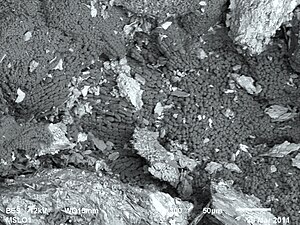115:. In all other myxogastria "subhypothallic" development takes place. Here, the hypothallus produces a layer on the plasmodium, which creates the rooms of the single fruit bodies during fructification. As the surrounding plasmodium flows in the fruit body, the hypothallus will lie directly on the substrate, shrinking and creating the edge of the mature fruit body. Here, the hypothallus is part of a morphological unit with peridium and stem, which serves as a membranous surface of the whole structure with the spores. Epihypothaly is an
17:
151:
127:
77:. Depending on the species, it can be membranous to thick or tender to solid and nearly transparent to brightly coloured. It may surround an individual fruit body, or may form a contiguous connection between multiple fruit bodies. In some rare cases it is missing entirely.
126:
310:
204:
293:
Higher-Order
Phylogeny of Plasmodial Slime Molds (Myxogastria) Based on Elongation Factor 1-A and Small Subunit rRNA Gene Sequences.
259:
Higher-Order
Phylogeny of Plasmodial Slime Molds (Myxogastria) Based on Elongation Factor 1-A and Small Subunit rRNA Gene Sequences.
224:
158:
279:
245:
219:
Reference for the paragraph: Henry
Stempen, Steven L. Stevenson: Myxomycetes. A Handbook of Slime Molds. Timber Press, 1994,
163:
50:
is the layer on which the fruit body sits, lying in contact with the substrate. The word is derived from the
70:
315:
16:
22:
93:
89:
199:(2nd ed.). St. Paul, Minnesota: The American Phytopathological Society. p. 296.
275:
241:
220:
200:
272:
Myxomyceten (Schleimpilze) und
Mycetozoa (Pilztiere) - Lebensformen zwischen Tier und Pflanze
238:
Myxomyceten (Schleimpilze) und
Mycetozoa (Pilztiere) - Lebensformen zwischen Tier und Pflanze
103:
the hypothallus may be involved in the formation of the fruit body. In the "epihypothallic"
81:
43:
257:
Reference for the paragraph: A.-M. Fiore-Donno, C. Berney, J. Pawlowski, S.L. Baldauf:
150:
74:
304:
51:
116:
172:
104:
35:
119:
of the stemonitida and is, in comparison to subhypothaly, a primitive feature.
31:
108:
84:, the hypothallus is the blackish lower layer of the thallus that produces
85:
63:
39:
112:
100:
15:
111:, up which the remaining plasmodium then rises, producing the
295:
In: Journal of
Eukaryotic Microbiology, 52, pp. 201–210, 2005
261:
In: Journal of
Eukaryotic Microbiology, 52, pp. 201–210, 2005
291:
A.-M. Fiore-Donno, C. Berney, J. Pawlowski, S.L. Baldauf:
26:. The clearly visible white material is the hypothallus.
107:, the hypothallus forms hollow, tubular stems and a
270:Reference for the paragraph: Wolfgang Nowotny:
8:
190:
188:
149:
195:Ulloa, Miguel; Halin, Richard T. (2012).
184:
20:Fruit body of a slime mold, possibly
7:
69:The hypothallus is produced by the
197:Illustrated Dictionary of Mycology
14:
125:
42:, and in species of the family
92:that attach the lichen to its
1:
311:Fungal morphology and anatomy
332:
164:Lithophyllum orbiculatum
27:
19:
73:at the beginning of
23:Tubifera ferruginosa
236:Wolfgang Nowotny:
28:
206:978-0-89054-400-6
323:
296:
289:
283:
268:
262:
255:
249:
234:
228:
217:
211:
210:
192:
161:Undersurface of
153:
145:
140:
135:
129:
82:crustose lichens
331:
330:
326:
325:
324:
322:
321:
320:
301:
300:
299:
290:
286:
269:
265:
256:
252:
235:
231:
218:
214:
207:
194:
193:
186:
182:
177:
176:
175:
160:
155:
154:
147:
146:
144:Underlying rock
143:
141:
138:
136:
133:
130:
44:Clavicipitaceae
12:
11:
5:
329:
327:
319:
318:
313:
303:
302:
298:
297:
284:
263:
250:
229:
212:
205:
183:
181:
178:
157:
156:
148:
142:
137:
132:
131:
124:
123:
122:
121:
75:fructification
58:("under") and
13:
10:
9:
6:
4:
3:
2:
328:
317:
314:
312:
309:
308:
306:
294:
288:
285:
281:
277:
273:
267:
264:
260:
254:
251:
247:
243:
239:
233:
230:
226:
225:0-88192-439-3
222:
216:
213:
208:
202:
198:
191:
189:
185:
179:
174:
170:
166:
165:
159:
152:
128:
120:
118:
114:
110:
106:
102:
97:
95:
91:
87:
83:
78:
76:
72:
67:
65:
62:("shoot" or "
61:
57:
53:
52:Ancient Greek
49:
45:
41:
37:
33:
25:
24:
18:
316:Cell biology
292:
287:
271:
266:
258:
253:
237:
232:
215:
196:
168:
162:
117:autapomorphy
98:
88:, which are
79:
68:
59:
55:
47:
29:
21:
282:, pp. 7–37.
248:, pp. 7–37.
173:perithallus
169:hypothallus
139:Hypothallus
134:Perithallus
105:Stemonitida
48:hypothallus
36:myxogastria
32:slime molds
305:Categories
280:3854740565
246:3854740565
180:References
167:, showing
71:plasmodium
109:columella
94:substrate
90:holdfasts
227:, p. 26.
99:In some
86:rhizines
30:In true
64:thallus
60:thallós
40:lichens
278:
244:
223:
203:
113:spores
46:, the
54:root
276:ISBN
274:In:
242:ISBN
240:In:
221:ISBN
201:ISBN
171:and
101:taxa
66:").
56:hypó
80:In
38:),
307::
187:^
96:.
209:.
34:(
Text is available under the Creative Commons Attribution-ShareAlike License. Additional terms may apply.


